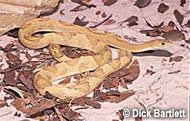Description:
Trans-Pecos rat snakes have a tremendous following in the United States. The Trans-Pecos rat snake has large, slightly protruding eyes, a pleasing pattern consisting of a series of dark, H-shaped blotches on the dorsum and a docile demeaner. Members of the rat snake clan can have stripes, blotches, or a combination of stripes and blotches; even unicolored species can be found. Rat snakes also have several representatives that are amelanistic (lacking black pigment) or leucistic (white coloration with blue eyes). Housing for the rat snake group can be simple. Cages should be escape-proof, roomy and well-ventilated. Hide boxes are appreciated by most forms. Substrates that work well include pine shavings, newsprint, indoor/outdoor carpeting or paper toweling. These animals do best with ventral heating–provide a heater on the bottom of one side of the cage setting up a temperature range from which the animal can select its preferred body temperature. These snakes can be maintained on adult mice or, as their name implies, rats.
Habitat:
Desert, bushy areas and rock piles.
Range:
The Chihuahuan Desert in Mexico, north into Texas. Areas surrounding the Pecos River.
Scientific Name: Bogertophis subocularis
Species Group: rat-snake
Family: Colubridae
Size: Almost 6 feet in length, although most are 4 feet or less.
Level: beginner
Weight:
Dangerous: No


